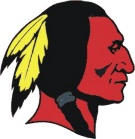Redface! |
 |
Indian Myths vs RealityClose your eyes and note what comes to mind when you hear the words "American Indian." No matter your political leanings and cultural sensitivity, the dominant images most people see are feathers, war paint, bows and arrows, buffalos, horses, teepees, beads, animal skins, and warfare. These images are a manifestation of cultural programming by adventure movies, books, photographs, museum exhibitions, films, television shows and documentaries. Common Stereotypes:
* Chief: the head of a tribe Western novelist Larry McMurtry described the vast gap between myth and reality in the depiction of the West in popular culture. "Most of the traditions which we associate with the American West," he wrote, "were invented by pulp writers, poster artists, impresarios, and advertising men."
The myth of the American Indian was further refined by frontiersman and master showman William Frederick Cody, better known as Buffalo Bill. In 1883, Cody formed Buffalo Bill's Wild West, a traveling show. The act included a mock battle with Indians, played, for the most part, by members of the Lakota Sioux tribe. Because Buffalo Bill's Wild West was as close as most Americans got to "real" Indians, Sioux traditions became, in the public mind, synonymous with all Indian customs. Firearms and mock battles were at the heart of the Wild West show Cody invented and first took on the road in 1883. It offered everything Western that wide-eyed Easterners hoped to see except the landscape: horses, elk and buffaloes; roping, riding and sharp shooting; simulated cyclones and prairie fires and gun battles and for a while, even Sitting Bull himself. Buffalo Bill was the Master of Ceremonies. Mounted on a handsome gray horse, he swept his big hat from his head to introduce his "Congress of Rough Riders of the World"; shot glass balls from the air; galloped to the rescue of a stagecoach and a settler's cabin surrounded by whooping Indians; and took center stage for a deeply affecting -- and entirely imaginary -- tableau in which he arrived only moments too late to save Custer and his command from annihilation.
Although the actual words stupid and dumb are seldom seen in
descriptions of Natives - perhaps because fighting a stupid enemy or
having a dumb sidekick is not especially flattering - Native Peoples
have been firmly placed in the lower echelons of intelligence by many
European Americans since first contact was made. Benevolent terms such
as "innocent," "primitive," and "unsaved"
indicate a lesser intelligence, and the more antagonistic descriptors
certainly point to comparative dimness. By the turn of the 20th Century, the Indian was viewed as a noble, primitive man in touch with nature, a master of self-sufficiency through hunting and fishing and making arrowheads, who knows the myths of his people. |

Buy a No
Soliciting Sign
That Really Works!
|
|
|
|
|
Redface! -- ContentsRacist Indian StereotypesHistory of Indian StereotypesRedface in Film and TVIndian Myths vs RealityIndian Stereotypes in Sports |
|
|
|||||
|
|
|
|
|
|
|
Racial and Racist Stereotypes in Media |
|||||
|
|
|||||